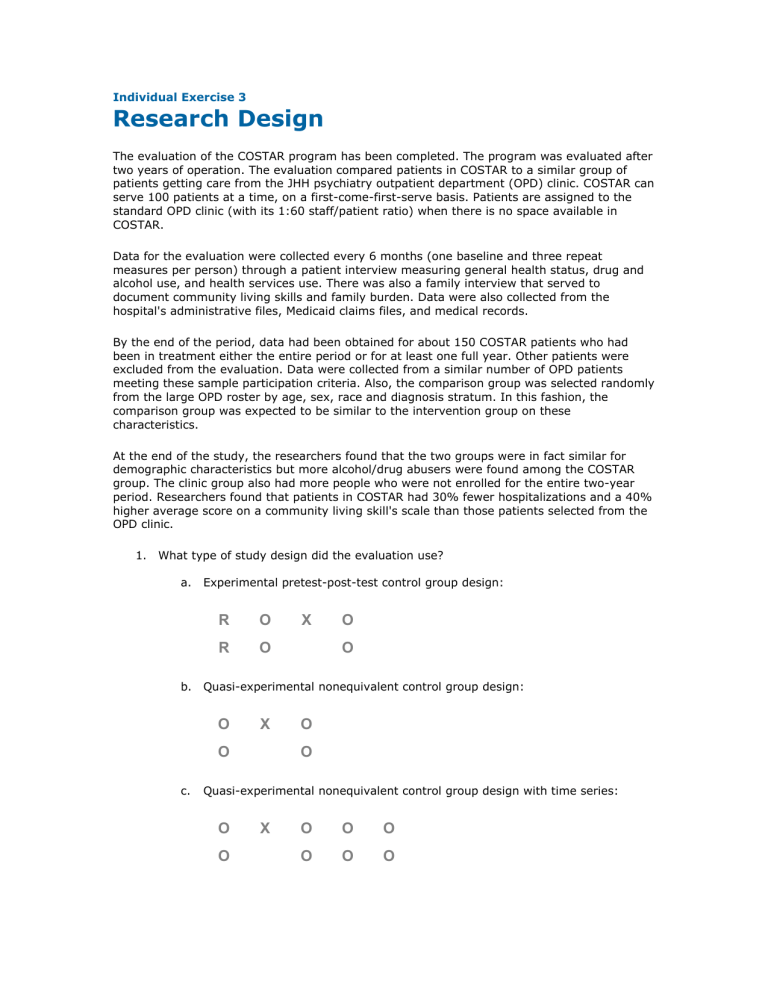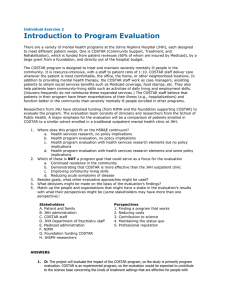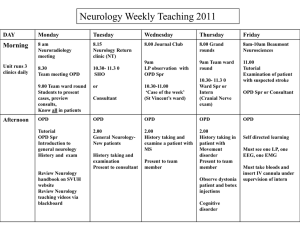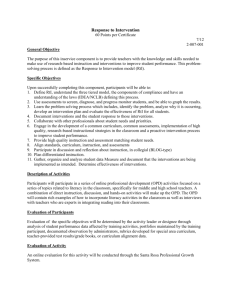Research Design

Individual Exercise 3
Research Design
The evaluation of the COSTAR program has been completed. The program was evaluated after two years of operation. The evaluation compared patients in COSTAR to a similar group of patients getting care from the JHH psychiatry outpatient department (OPD) clinic. COSTAR can serve 100 patients at a time, on a first-come-first-serve basis. Patients are assigned to the standard OPD clinic (with its 1:60 staff/patient ratio) when there is no space available in
COSTAR.
Data for the evaluation were collected every 6 months (one baseline and three repeat measures per person) through a patient interview measuring general health status, drug and alcohol use, and health services use. There was also a family interview that served to document community living skills and family burden. Data were also collected from the hospital's administrative files, Medicaid claims files, and medical records.
By the end of the period, data had been obtained for about 150 COSTAR patients who had been in treatment either the entire period or for at least one full year. Other patients were excluded from the evaluation. Data were collected from a similar number of OPD patients meeting these sample participation criteria. Also, the comparison group was selected randomly from the large OPD roster by age, sex, race and diagnosis stratum. In this fashion, the comparison group was expected to be similar to the intervention group on these characteristics.
At the end of the study, the researchers found that the two groups were in fact similar for demographic characteristics but more alcohol/drug abusers were found among the COSTAR group. The clinic group also had more people who were not enrolled for the entire two-year period. Researchers found that patients in COSTAR had 30% fewer hospitalizations and a 40% higher average score on a community living skill's scale than those patients selected from the
OPD clinic.
1.
What type of study design did the evaluation use?
a.
Experimental pretest-post-test control group design:
R O X O
R O O b.
Quasi-experimental nonequivalent control group design:
O X O
O O c.
Quasi-experimental nonequivalent control group design with time series:
O X O O O
O O O O
2.
Identify which of the following are the independent, dependent and intervening variables: a.
Program type (COSTAR or OPD) b.
Age c.
Hospitalizations d.
Gender e.
Race f.
Diagnostic Group g.
Community living skills
3.
What are some of the key threats to the study's internal validity?
4.
What are some threats to the study's external validity? How generalizable are its results?
5.
How could the study design be improved?
ANSWERS
1.
C: First, there was no randomization of patients to the study or comparison group, although there was random selection of comparison group members from the OPD patient population, hence this was not an experimental study. Second, the time series element comes from the three follow-up data collection efforts.
2.
Independent: (A) Program type (COSTAR or OPD)
Dependent: (C) Hospitalizations, (G) Community living skills
Intervening: (B) Age, (D) Gender, (E) Race, and (F) Diagnostic group
3.
Selection bias: OPD patients may differ from COSTAR patients on important characteristics
Instrumentation: Changes in research interviewers over the course of the study may unwittingly bias data collection
4.
Reactive (Hawthorne) effects: Research staff could not be blinded to participant's group assignment, and may unwittingly have influenced responses, especially to questions about satisfaction.
Selection-treatment interaction: The setting for the study (JHH, COSTAR structure may be unusual, so that a replication in another site may not show the same results.
Testing-treatment interaction: The repeated interviews which asked patients to evaluate their experience may have had an impact in and of themselves, so that the effect of the program was compounded and appeared greater than it might without such data collection efforts.
5.
(1) Randomize patients to COSTAR and OPD groups; (2) Add a cost-benefit analysis component





